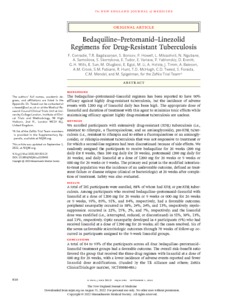Conradie, F;
Bagdasaryan, TR;
Borisov, S;
Howell, P;
Mikiashvili, L;
Ngubane, N;
Samoilova, A;
Skornykova, S;
Tudor, E;
Variava, E;
et al.
Conradie, F; Bagdasaryan, TR; Borisov, S; Howell, P; Mikiashvili, L; Ngubane, N; Samoilova, A; Skornykova, S; Tudor, E; Variava, E; Yablonskiy, P; Everitt, D; Wills, GH; Sun, E; Olugbosi, M; Egizi, E; Li, M; Holsta, A; Timm, J; Bateson, A; Crook, AM; Fabiane, SM; Hunt, R; McHugh, TD; Tweed, CD; Foraida, S; Mendel, CM; Spigelman, M
(2022)
Bedaquiline–Pretomanid–Linezolid Regimens for Drug-Resistant Tuberculosis.
New England Journal of Medicine, 387 (9).
pp. 810-823.
ISSN 0028-4793
https://doi.org/10.1056/nejmoa2119430
SGUL Authors: Witney, Adam Austin
![[img]](https://openaccess.sgul.ac.uk/114768/1.hassmallThumbnailVersion/NEJMoa2119430.pdf)  Preview |
|
PDF
Published Version
Available under License ["licenses_description_publisher" not defined].
Download (614kB)
| Preview
|
Abstract
Background
The bedaquiline–pretomanid–linezolid regimen has been reported to have 90% efficacy against highly drug-resistant tuberculosis, but the incidence of adverse events with 1200 mg of linezolid daily has been high. The appropriate dose of linezolid and duration of treatment with this agent to minimize toxic effects while maintaining efficacy against highly drug-resistant tuberculosis are unclear.
Methods
We enrolled participants with extensively drug-resistant (XDR) tuberculosis (i.e., resistant to rifampin, a fluoroquinolone, and an aminoglycoside), pre-XDR tuberculosis (i.e., resistant to rifampin and to either a fluoroquinolone or an aminoglycoside), or rifampin-resistant tuberculosis that was not responsive to treatment or for which a second-line regimen had been discontinued because of side effects. We randomly assigned the participants to receive bedaquiline for 26 weeks (200 mg daily for 8 weeks, then 100 mg daily for 18 weeks), pretomanid (200 mg daily for 26 weeks), and daily linezolid at a dose of 1200 mg for 26 weeks or 9 weeks or 600 mg for 26 weeks or 9 weeks. The primary end point in the modified intention-to-treat population was the incidence of an unfavorable outcome, defined as treatment failure or disease relapse (clinical or bacteriologic) at 26 weeks after completion of treatment. Safety was also evaluated.
Results
A total of 181 participants were enrolled, 88% of whom had XDR or pre-XDR tuberculosis. Among participants who received bedaquiline–pretomanid–linezolid with linezolid at a dose of 1200 mg for 26 weeks or 9 weeks or 600 mg for 26 weeks or 9 weeks, 93%, 89%, 91%, and 84%, respectively, had a favorable outcome; peripheral neuropathy occurred in 38%, 24%, 24%, and 13%, respectively; myelosuppression occurred in 22%, 15%, 2%, and 7%, respectively; and the linezolid dose was modified (i.e., interrupted, reduced, or discontinued) in 51%, 30%, 13%, and 13%, respectively. Optic neuropathy developed in 4 participants (9%) who had received linezolid at a dose of 1200 mg for 26 weeks; all the cases resolved. Six of the seven unfavorable microbiologic outcomes through 78 weeks of follow-up occurred in participants assigned to the 9-week linezolid groups.
Conclusions
A total of 84 to 93% of the participants across all four bedaquiline–pretomanid–linezolid treatment groups had a favorable outcome. The overall risk–benefit ratio favored the group that received the three-drug regimen with linezolid at a dose of 600 mg for 26 weeks, with a lower incidence of adverse events reported and fewer linezolid dose modifications. (Funded by the TB Alliance and others; ZeNix ClinicalTrials.gov number, NCT03086486. opens in new tab.)
| Item Type: |
Article
|
| Additional Information: |
From New England Journal of Medicine, Conradie, F; Bagdasaryan, TR; Borisov, S; Howell, P; Mikiashvili, L; Ngubane, N; Samoilova, A; Skornykova, S; Tudor, E; Variava, E; et al., New England Journal of Medicine, 387, 810-823. Copyright © (2022) Massachusetts Medical Society. Reprinted with permission. |
| Keywords: |
11 Medical and Health Sciences, General & Internal Medicine |
| SGUL Research Institute / Research Centre: |
Academic Structure > Infection and Immunity Research Institute (INII) |
| Journal or Publication Title: |
New England Journal of Medicine |
| ISSN: |
0028-4793 |
| Language: |
en |
| Dates: |
| Date | Event |
|---|
| 1 September 2022 | Published | | 7 July 2022 | Accepted |
|
| Publisher License: |
Publisher's own licence |
| Projects: |
|
| URI: |
https://openaccess.sgul.ac.uk/id/eprint/114768 |
| Publisher's version: |
https://doi.org/10.1056/nejmoa2119430 |
Statistics
Item downloaded times since 05 Sep 2022.
Actions (login required)
 |
Edit Item |


